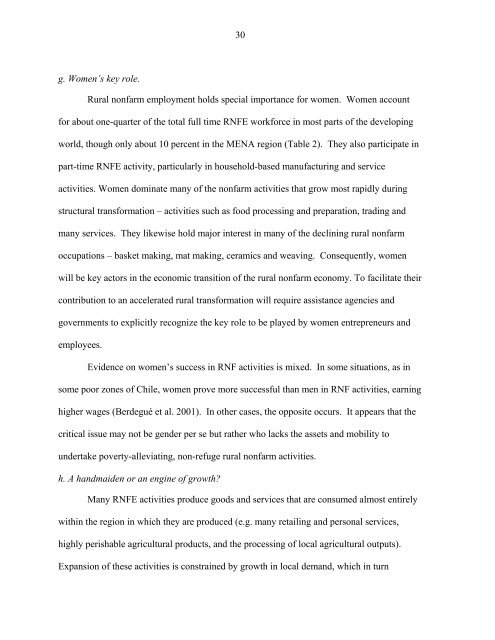Strategies for Stimulating Poverty-alleviating Growth in the Rural ...
Strategies for Stimulating Poverty-alleviating Growth in the Rural ...
Strategies for Stimulating Poverty-alleviating Growth in the Rural ...
Create successful ePaper yourself
Turn your PDF publications into a flip-book with our unique Google optimized e-Paper software.
30<br />
g. Women’s key role.<br />
<strong>Rural</strong> nonfarm employment holds special importance <strong>for</strong> women. Women account<br />
<strong>for</strong> about one-quarter of <strong>the</strong> total full time RNFE work<strong>for</strong>ce <strong>in</strong> most parts of <strong>the</strong> develop<strong>in</strong>g<br />
world, though only about 10 percent <strong>in</strong> <strong>the</strong> MENA region (Table 2). They also participate <strong>in</strong><br />
part-time RNFE activity, particularly <strong>in</strong> household-based manufactur<strong>in</strong>g and service<br />
activities. Women dom<strong>in</strong>ate many of <strong>the</strong> nonfarm activities that grow most rapidly dur<strong>in</strong>g<br />
structural trans<strong>for</strong>mation – activities such as food process<strong>in</strong>g and preparation, trad<strong>in</strong>g and<br />
many services. They likewise hold major <strong>in</strong>terest <strong>in</strong> many of <strong>the</strong> decl<strong>in</strong><strong>in</strong>g rural nonfarm<br />
occupations – basket mak<strong>in</strong>g, mat mak<strong>in</strong>g, ceramics and weav<strong>in</strong>g. Consequently, women<br />
will be key actors <strong>in</strong> <strong>the</strong> economic transition of <strong>the</strong> rural nonfarm economy. To facilitate <strong>the</strong>ir<br />
contribution to an accelerated rural trans<strong>for</strong>mation will require assistance agencies and<br />
governments to explicitly recognize <strong>the</strong> key role to be played by women entrepreneurs and<br />
employees.<br />
Evidence on women’s success <strong>in</strong> RNF activities is mixed. In some situations, as <strong>in</strong><br />
some poor zones of Chile, women prove more successful than men <strong>in</strong> RNF activities, earn<strong>in</strong>g<br />
higher wages (Berdegué et al. 2001). In o<strong>the</strong>r cases, <strong>the</strong> opposite occurs. It appears that <strong>the</strong><br />
critical issue may not be gender per se but ra<strong>the</strong>r who lacks <strong>the</strong> assets and mobility to<br />
undertake poverty-<strong>alleviat<strong>in</strong>g</strong>, non-refuge rural nonfarm activities.<br />
h. A handmaiden or an eng<strong>in</strong>e of growth?<br />
Many RNFE activities produce goods and services that are consumed almost entirely<br />
with<strong>in</strong> <strong>the</strong> region <strong>in</strong> which <strong>the</strong>y are produced (e.g. many retail<strong>in</strong>g and personal services,<br />
highly perishable agricultural products, and <strong>the</strong> process<strong>in</strong>g of local agricultural outputs).<br />
Expansion of <strong>the</strong>se activities is constra<strong>in</strong>ed by growth <strong>in</strong> local demand, which <strong>in</strong> turn
















